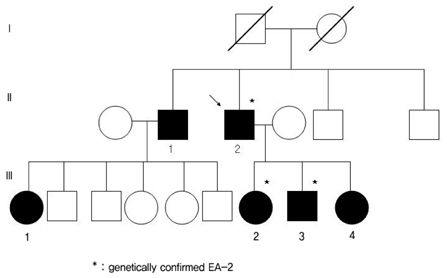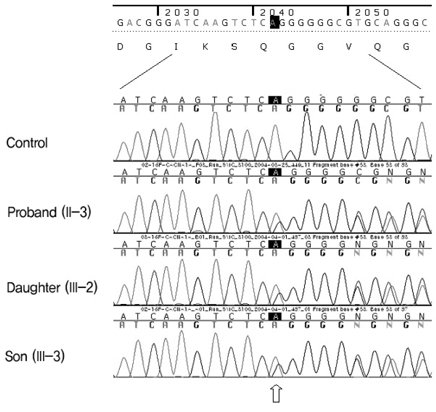J Clin Neurol.
2006 Dec;2(4):268-271. 10.3988/jcn.2006.2.4.268.
Episodic Ataxia Type 2 due to a Deletion Mutation in the CACNA1A Gene in a Korean Family
- Affiliations
-
- 1Department of Neurology, College of Medicine, Seoul National University, Korea. brain@snu.ac.kr
- 2Department of Laboratory Medicine, Samsung Medical Center, Sungkyunkwan University School of Medicine, Korea.
- KMID: 1980468
- DOI: http://doi.org/10.3988/jcn.2006.2.4.268
Abstract
- Episodic ataxia type 2 (EA-2) is an inherited disorder that is characterized by intermittent vertigo, ataxia, and interictal gaze-evoked nystagmus. Although abnormalities associated with this disorder have been found in the CACNA1A gene encoding the alpha1A (Cav2.1) subunit of the P/Q-type calcium channel, there are few reports of genetically confirmed EA-2 in Korea. In 1998, a Korean family with acetazolamide-responsive hereditary paroxysmal ataxia was reported, but the genetic background was not defined at that time. In the present study we performed direct sequencing of the entire exons and their flanking intronic sequences of the CACNA1A gene and found a deletion mutation (c.2042_2043delAG).
Keyword
Figure
Reference
-
1. Bain PG, O'Brien MD, Keevil SF, Porter DA. Familial periodic cerebellar ataxia: a problem of cerebellar intracellular pH homeostasis. Ann Neurol. 1992. 31:147–154.
Article2. Koh SH, Kim HT, Kim SH, Lee GY, Kim J, Kim MH. Spinocerebellar ataxia type 6 and episodic ataxia type 2 in a Korean family. J Korean Med Sci. 2001. 16:809–813.
Article3. Yun S, Chang YJ, Jung SC, Kwon JW, Lee GH, Lee CM, et al. Episodic ataxia type 2 with downbeating nystagmus caused by mutation in the CACNA1A: a case report. J Korean Neurol Assoc. 2005. 23:399–401.4. Kim HJ, Jeon BS. Acetazolamide-responsive hereditary paroxysmal ataxia: report of a family. J Korean Med Sci. 1998. 13:196–200.
Article5. Vaamonde J, Artieda J, Obeso JA. Hereditary paroxysmal ataxia with neuromyotonia. Mov Disord. 1991. 6:180–182.
Article6. Browne DL, Gancher ST, Nutt JG, Brunt ER, Smith EA, Kramer P, et al. Episodic ataxia/myokymia syndrome is associated with point mutations in the human potassium channel gene, KCNA1. Nat Genet. 1994. 8:136–140.
Article7. Mori Y, Friedrich T, Kim MS, Mikami A, Nakai J, Ruth P, et al. Primary structure and functional expression from complementary DNA of a brain calcium channel. Nature. 1991. 350:398–402.
Article8. Fletcher CF, Lutz CM, O'Sullivan TN, Shaughnessy JD Jr, Hawkes R, Frankel WN, Copeland NG, Jenkins NA. Absence epilepsy in tottering mutant mice is associated with calcium channel defects. Cell. 1996. 87:607–617.
Article9. Harding AE. Clinical features and classification of inherited ataxias. Adv Neurol. 1993. 61:1–14.10. Jen J, Kim GW, Baloh RW. Clinical spectrum of episodic ataxia type 2. Neurology. 2004. 62:17–22.
Article11. Denier C, Ducros A, Vahedi K, Joutel A, Thierry P, Ritz A, et al. High prevalence of CACNA1A truncations and broader clinical spectrum in episodic ataxia type 2. Neurology. 1999. 52:1816–1821.
Article12. Humm AM, Beer S, Kool J, Magistris MR, Kesselring J, Rosler KM. Quantification of Uhthoff's phenomenon in multiple sclerosis: a magnetic stimulation study. Clin Neurophysiol. 2004. 115:2493–2501.
Article13. Cianfrone G, Turchetta R, Mazzei F, Bartolo M, Parisi L. Temperature-dependent auditory neuropathy: is it an acoustic Uhthoff-like phenomenon? A case report. Ann Otol Rhinol Laryngol. 2006. 115:518–527.
Article
- Full Text Links
- Actions
-
Cited
- CITED
-
- Close
- Share
- Similar articles
-
- Episodic Ataxia Type 2 with Downbeating Nystagmus Caused by Mutation in the CACNA1A: A Case Report
- Spinocerebellar Ataxia Type 6 and Episodic Ataxia Type 2 in a Korean Family
- New Nonsense Variant c.2983G>T; p.Glu995* in the CACNA1A Gene Causes Progressive Autosomal Dominant Ataxia
- Effective ketogenic diet in CACNA1A-related ‘epilepsy of infancy with migrating focal seizures’
- Episodic Ataxias: Clinical and Genetic Features



